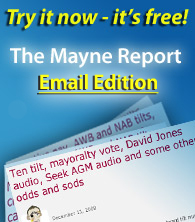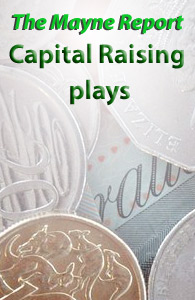Great debate at the Babcock AGM
February 2, 2010
Dear Mayne Reporters, greetings from a huge net cafe in Surry Hills full of foul-mouthed game-playing students,
The Babcock & Brown AGM went from 10am until about 12.30pm at Sydney's Sofitel Hotel today and a hefty 55 minutes of it was taken up by debate triggered by The Mayne Report.
Whilst supposedly lead independent director Elizabeth Nosworthy took great exception to questions about her independence and launched into a detailed defence in what became the longest exchange of the AGM, more than 10 shareholders came after the meeting to say they enjoyed the debate and learnt plenty of new things about Babcock.
Even executive chairman Jim Babcock came over to say "thanks" and that he "supports gadflys".
Is Babcock reviewing its broken model or not?
The big news from the meeting came from CEO Phil Green's response to the attack on the flawed Babcock listed fund model. After some warm up questions which extracted the news that Babcock's investments in the funds are currently about $120 million under water and that the full management agreements would not be released because they contained some clauses that were the "intellectual property" of Babcock, I let fly with this spray.
The key points were that the market has completely lost faith with the listed funds model, the governance and accountability is appalling, the debt is too high, the conflicts too great and the huge discounts to NTA render all them fundamentally broken such that management should be internalised or some other major restructure pursued.
Phil Green responded by welcoming the comments and then declaring a review of all of them. Fairfax reporter Stuart Washington then left the AGM and filed this story for The Age and The SMH which included the following:
"Our first step obviously is to restore the capital strength of BBP," he said. "We will then look at all our funds to see whether that strategic position fits and how we deal with it."
Mr Green said Babcock may consider internalising or privatising assets if it felt that the unit prices of the funds would remain below the underlying value of their assets.
Fast forward 90 minutes to the press conference and Phil Green was backing off at a million miles, saying the possibility of privatisating or internalising the management was only really being considered with the likes of Babcock & Brown Capital and, to a lesser extent, Babcock & Brown Wind where a major asset sale program is underway.
Have a listen to the full exchange and make up your own mind.
Chairman Jim feels our pain as nervous Phil gulps water
Babcock shares have plunged about 70% since shareholders last met and you won't hear too many more "I feel your pain" speeches than what executive chairman and co-founder Jim Babcock served up today. And Phil Green was clearly very nervous as he gulped two sips of water in his first minute at the podium.
Check out the formal addresses from the dynamic duo because they didn't really get to the heart of the problems besetting Babcock at the moment, despite a better attempt than what we saw from Macquarie Airports last week.
That said, the Babcock team should be commended for the fullness of their answers during the debate. We heard from five different directors and the two New York directors were beamed in from the Big Apple for the duration of proceedings.
The board composition debate
Jim Babcock was keen to tell us very early in proceedings that the main proxy advisory firms had recommended in favour of all 18 resolutions, although some comments from the box tickers had been made about board composition and governance that would be taken on board.
However, the only real nod to improved governance we got today was Jim's decision to stand down from the chairmanship of the nomination and governance committee, to be replaced by Elizabeth Nosworthy whose commercial dealings with Babcock are just too broad in my book for her to considered a genuine independent.
Asked "the John Howard question" in the same room where John Howard conceded defeat last November, Jim said he intended to serve a full term as executive chairman. And when shareholders approved the increase in pay for non-executive directors from $1.5 million to $2.5 million, he didn't even say this was to provide head-room to appoint additional independent directors who would then give Babcock a clear majority of indepdendent NEDs. That's a shame as the market is looking for a lot more from this mob on governance.
Puzzling proxy votes
The proxy advisers might have backed all the resolutions but one of Babcock's two biggest institutional shareholders, FMR or Barclays, clearly decided to send Babcock a message because the against vote on the eight resolutions related to executives getting shares in lieu of cash bonuses had almost 20% of the shares voted against, although these were only worth about $300 million in $4 billion company.
Check out the full proxy votes because it was indeed strange to see only 3 million shares voted against the remuneration report and more than 20 million against these other pay-related resolutions.
Still controlled by the Babcock boys
Babcock is never going to have a major problem passing contentious resolutions because Phil Green estimated today that about 40% of the stock is still owned by the staff. That's the equivalent of about $1.8 billion worth of shares and Phil said none of the key executives had margin loans that were even close to being material.
However, it was interesting that Phil said he had never taken up the dividend reinvestment plan. Sure, he needs to keep a balanced portfolio, but does he need the cash at the moment?
Then again, cash bonuses have been largely abandoned in lieu of scrip, so Phil and the rest of the team were today approved to receive about $100 million worth of stock. Given that Babcock has been involved in major negotiations with its banks over recent months, it is very interesting that they made this change to conserve about $100 million of cash, at the same time increased the overall executive ownership of the firm.
Whilst Macquarie Bank is now only about 5% owned by its staff, the heart of Babcock is ultimately the 10-20 blokes who together control about $1.5 billion worth of shares.
The company's ability to respond to the current crisis will ultimately be dictated by the financial strength of these former partners in a private investment bank. It is remarkably similar to the Allco model, which collapsed spectacularly over the past few months because David Coe and the boys just couldn't withstand the plunging share price and were personally carrying too much debt.
Babcock & Brown Power desperately needs some big assets sales or an injection of fresh equity and it remains to be seen just how financial strong these Babcock boys really are as they frenetically juggle excessive debt, reputational hits and a complete loss of confidence from the investment community.
I reckon a merger of Babcock & Brown Wind, Babcock & Brown Power and Babcock & Brown Infrastructure into one internally managed Australian infrastructure and energy power house is the way to go, but it remains to be seen if the boys will surrender all these guaranteed fees that flow from the troubled third party asset management model.
Summary of all the audio action
Forget about these words, listen to some of these great audio exchange. I particularly recommend numbers 3, 4, 6, 10 and 13 but they're all worth a go and only the Nosworthy independence battles drags on a bit.
1. Why weren't we offered a share purchase plan after the recent discounted institutional placement?
2. Do any of the directors have margin loans on their stock?
3. How far under water are our investments in the listed funds?
4. Is ASX director Michael Sharpe satisfied with our failure to disclose the listed fund management agreements?
5. The legal obligation question
6. The model we are running is actually broken
7.Shareholder support about the broken model and poor governance
8. Did the proxy advisers really all support the remuneration report and how much stock do the staff own?
9. Heavy combat with Elizabeth Nosworthy over her independence
10. Attempt to nail director Joe Raby with resurrection of Alan Bond - slapped down by Nosworthy
11. Why the big protest vote against the deferred bonus share grants?
12. Why issue shares in lieu of cash bonuses at just $12.82 and how much cash has this change of policy saved us?
13. Phil Green confesses to never having participated in the dividend reinvestment plan
14. Strong support for increase in NED pay - always nice to finish on a positive note.
That's all for now.
Do ya best, Stephen Mayne
PS. Check out Sky Business Report at 8.30pm tonight on Sky News for a quick interview about the Babcock AGM.
* The Mayne Report is a multi-media governance website published by Stephen Mayne with occasional email editions. To unsubscribe from the emails click here.
The Babcock & Brown AGM went from 10am until about 12.30pm at Sydney's Sofitel Hotel today and a hefty 55 minutes of it was taken up by debate triggered by The Mayne Report.
Whilst supposedly lead independent director Elizabeth Nosworthy took great exception to questions about her independence and launched into a detailed defence in what became the longest exchange of the AGM, more than 10 shareholders came after the meeting to say they enjoyed the debate and learnt plenty of new things about Babcock.
Even executive chairman Jim Babcock came over to say "thanks" and that he "supports gadflys".
Is Babcock reviewing its broken model or not?
The big news from the meeting came from CEO Phil Green's response to the attack on the flawed Babcock listed fund model. After some warm up questions which extracted the news that Babcock's investments in the funds are currently about $120 million under water and that the full management agreements would not be released because they contained some clauses that were the "intellectual property" of Babcock, I let fly with this spray.
The key points were that the market has completely lost faith with the listed funds model, the governance and accountability is appalling, the debt is too high, the conflicts too great and the huge discounts to NTA render all them fundamentally broken such that management should be internalised or some other major restructure pursued.
Phil Green responded by welcoming the comments and then declaring a review of all of them. Fairfax reporter Stuart Washington then left the AGM and filed this story for The Age and The SMH which included the following:
"Our first step obviously is to restore the capital strength of BBP," he said. "We will then look at all our funds to see whether that strategic position fits and how we deal with it."
Mr Green said Babcock may consider internalising or privatising assets if it felt that the unit prices of the funds would remain below the underlying value of their assets.
Fast forward 90 minutes to the press conference and Phil Green was backing off at a million miles, saying the possibility of privatisating or internalising the management was only really being considered with the likes of Babcock & Brown Capital and, to a lesser extent, Babcock & Brown Wind where a major asset sale program is underway.
Have a listen to the full exchange and make up your own mind.
Chairman Jim feels our pain as nervous Phil gulps water
Babcock shares have plunged about 70% since shareholders last met and you won't hear too many more "I feel your pain" speeches than what executive chairman and co-founder Jim Babcock served up today. And Phil Green was clearly very nervous as he gulped two sips of water in his first minute at the podium.
Check out the formal addresses from the dynamic duo because they didn't really get to the heart of the problems besetting Babcock at the moment, despite a better attempt than what we saw from Macquarie Airports last week.
That said, the Babcock team should be commended for the fullness of their answers during the debate. We heard from five different directors and the two New York directors were beamed in from the Big Apple for the duration of proceedings.
The board composition debate
Jim Babcock was keen to tell us very early in proceedings that the main proxy advisory firms had recommended in favour of all 18 resolutions, although some comments from the box tickers had been made about board composition and governance that would be taken on board.
However, the only real nod to improved governance we got today was Jim's decision to stand down from the chairmanship of the nomination and governance committee, to be replaced by Elizabeth Nosworthy whose commercial dealings with Babcock are just too broad in my book for her to considered a genuine independent.
Asked "the John Howard question" in the same room where John Howard conceded defeat last November, Jim said he intended to serve a full term as executive chairman. And when shareholders approved the increase in pay for non-executive directors from $1.5 million to $2.5 million, he didn't even say this was to provide head-room to appoint additional independent directors who would then give Babcock a clear majority of indepdendent NEDs. That's a shame as the market is looking for a lot more from this mob on governance.
Puzzling proxy votes
The proxy advisers might have backed all the resolutions but one of Babcock's two biggest institutional shareholders, FMR or Barclays, clearly decided to send Babcock a message because the against vote on the eight resolutions related to executives getting shares in lieu of cash bonuses had almost 20% of the shares voted against, although these were only worth about $300 million in $4 billion company.
Check out the full proxy votes because it was indeed strange to see only 3 million shares voted against the remuneration report and more than 20 million against these other pay-related resolutions.
Still controlled by the Babcock boys
Babcock is never going to have a major problem passing contentious resolutions because Phil Green estimated today that about 40% of the stock is still owned by the staff. That's the equivalent of about $1.8 billion worth of shares and Phil said none of the key executives had margin loans that were even close to being material.
However, it was interesting that Phil said he had never taken up the dividend reinvestment plan. Sure, he needs to keep a balanced portfolio, but does he need the cash at the moment?
Then again, cash bonuses have been largely abandoned in lieu of scrip, so Phil and the rest of the team were today approved to receive about $100 million worth of stock. Given that Babcock has been involved in major negotiations with its banks over recent months, it is very interesting that they made this change to conserve about $100 million of cash, at the same time increased the overall executive ownership of the firm.
Whilst Macquarie Bank is now only about 5% owned by its staff, the heart of Babcock is ultimately the 10-20 blokes who together control about $1.5 billion worth of shares.
The company's ability to respond to the current crisis will ultimately be dictated by the financial strength of these former partners in a private investment bank. It is remarkably similar to the Allco model, which collapsed spectacularly over the past few months because David Coe and the boys just couldn't withstand the plunging share price and were personally carrying too much debt.
Babcock & Brown Power desperately needs some big assets sales or an injection of fresh equity and it remains to be seen just how financial strong these Babcock boys really are as they frenetically juggle excessive debt, reputational hits and a complete loss of confidence from the investment community.
I reckon a merger of Babcock & Brown Wind, Babcock & Brown Power and Babcock & Brown Infrastructure into one internally managed Australian infrastructure and energy power house is the way to go, but it remains to be seen if the boys will surrender all these guaranteed fees that flow from the troubled third party asset management model.
Summary of all the audio action
Forget about these words, listen to some of these great audio exchange. I particularly recommend numbers 3, 4, 6, 10 and 13 but they're all worth a go and only the Nosworthy independence battles drags on a bit.
1. Why weren't we offered a share purchase plan after the recent discounted institutional placement?
2. Do any of the directors have margin loans on their stock?
3. How far under water are our investments in the listed funds?
4. Is ASX director Michael Sharpe satisfied with our failure to disclose the listed fund management agreements?
5. The legal obligation question
6. The model we are running is actually broken
7.Shareholder support about the broken model and poor governance
8. Did the proxy advisers really all support the remuneration report and how much stock do the staff own?
9. Heavy combat with Elizabeth Nosworthy over her independence
10. Attempt to nail director Joe Raby with resurrection of Alan Bond - slapped down by Nosworthy
11. Why the big protest vote against the deferred bonus share grants?
12. Why issue shares in lieu of cash bonuses at just $12.82 and how much cash has this change of policy saved us?
13. Phil Green confesses to never having participated in the dividend reinvestment plan
14. Strong support for increase in NED pay - always nice to finish on a positive note.
That's all for now.
Do ya best, Stephen Mayne
PS. Check out Sky Business Report at 8.30pm tonight on Sky News for a quick interview about the Babcock AGM.
* The Mayne Report is a multi-media governance website published by Stephen Mayne with occasional email editions. To unsubscribe from the emails click here.





















